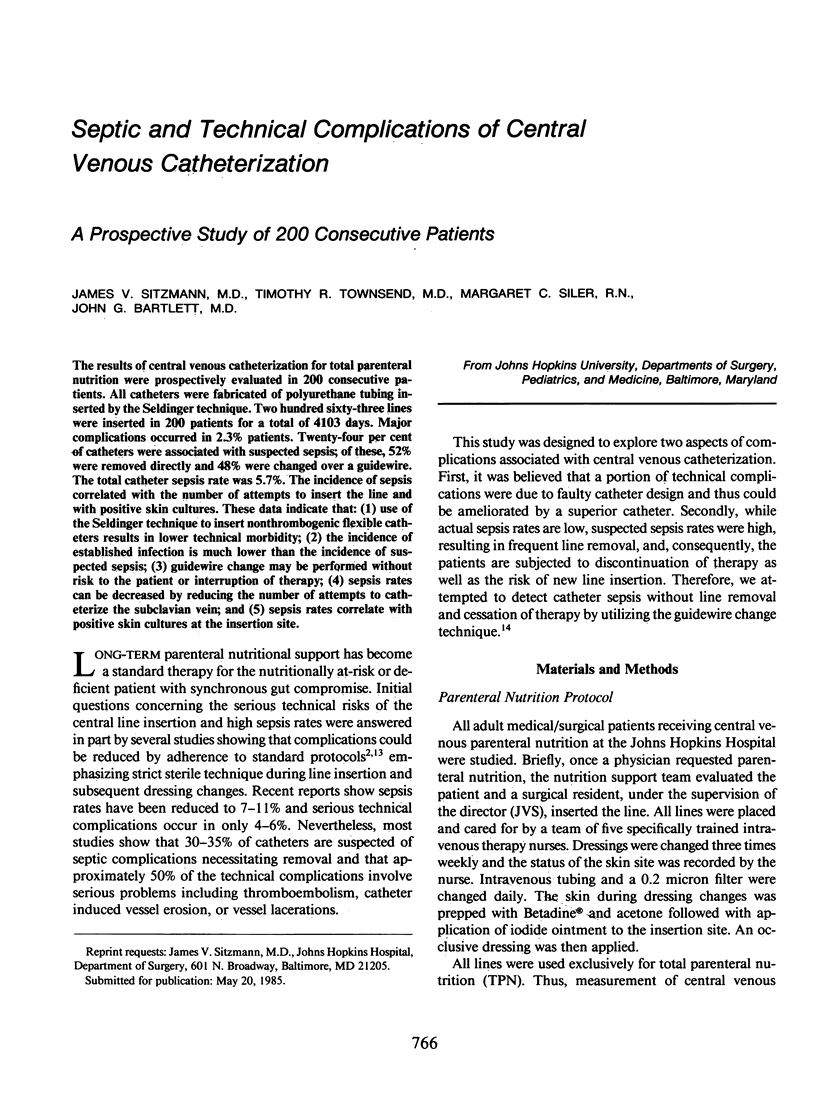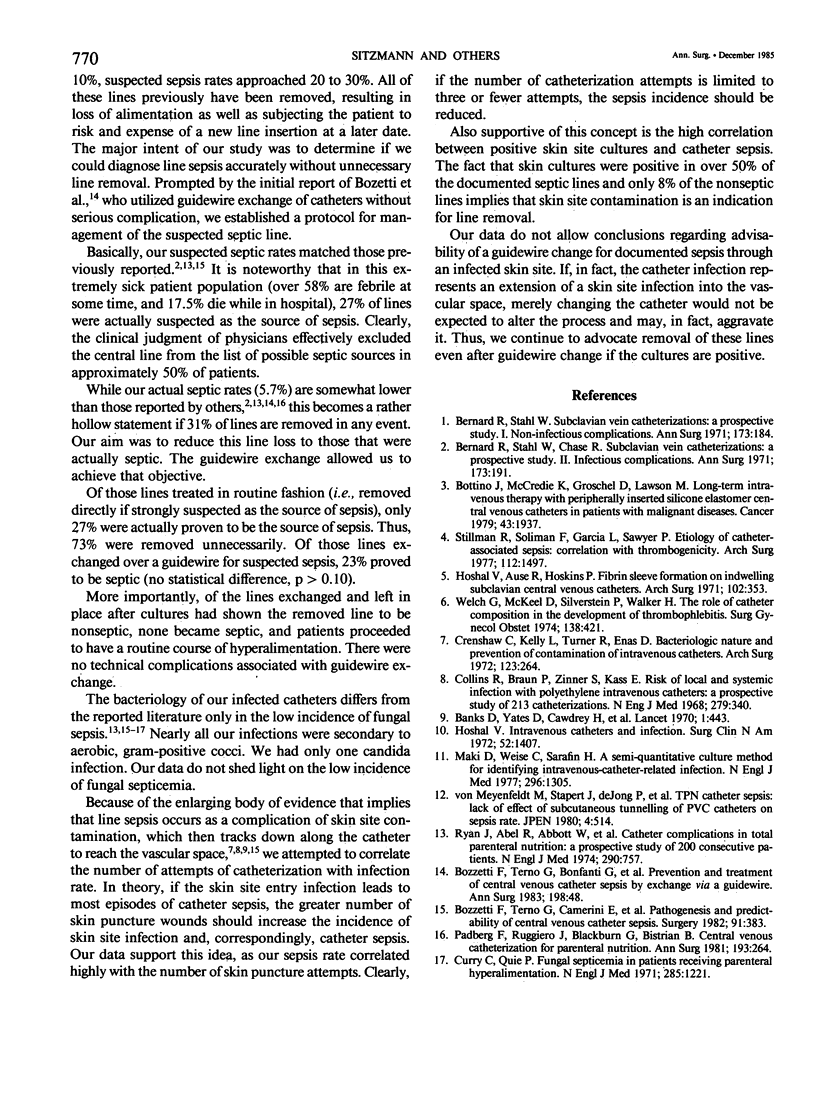Abstract
The results of central venous catheterization for total parenteral nutrition were prospectively evaluated in 200 consecutive patients. All catheters were fabricated of polyurethane tubing inserted by the Seldinger technique. Two hundred sixty-three lines were inserted in 200 patients for a total of 4103 days. Major complications occurred in 2.3% patients. Twenty-four per cent of catheters were associated with suspected sepsis; of these, 52% were removed directly and 48% were changed over a guidewire. The total catheter sepsis rate was 5.7%. The incidence of sepsis correlated with the number of attempts to insert the line and with positive skin cultures. These data indicate that: use of the Seldinger technique to insert nonthrombogenic flexible catheters results in lower technical morbidity; the incidence of established infection is much lower than the incidence of suspected sepsis; guidewire change may be performed without risk to the patient or interruption of therapy; sepsis rates can be decreased by reducing the number of attempts to catheterize the subclavian vein; and sepsis rates correlate with positive skin cultures at the insertion site.
Full text
PDF




Selected References
These references are in PubMed. This may not be the complete list of references from this article.
- Banks D. C., Yates D. B., Cawdrey H. M., Harries M. G., Kidner P. H. Infection from intravenous catheters. Lancet. 1970 Feb 28;1(7644):443–445. doi: 10.1016/s0140-6736(70)90833-0. [DOI] [PubMed] [Google Scholar]
- Bernard R. W., Stahl W. M., Chase R. M., Jr Subclavian vein catheterizations: a prospective study. II. Infectious complications. Ann Surg. 1971 Feb;173(2):191–200. doi: 10.1097/00000658-197102000-00003. [DOI] [PMC free article] [PubMed] [Google Scholar]
- Bernard R. W., Stahl W. M. Subclavian vein catheterizations: a prospective study. I. Non-infectious complications. Ann Surg. 1971 Feb;173(2):184–190. doi: 10.1097/00000658-197102000-00002. [DOI] [PMC free article] [PubMed] [Google Scholar]
- Bottino J., McCredie K. B., Groschel D. H., Lawson M. Long-term intravenous therapy with peripherally inserted silicone elastomer central venous catheters in patients with malignant diseases. Cancer. 1979 May;43(5):1937–1943. doi: 10.1002/1097-0142(197905)43:5<1937::aid-cncr2820430554>3.0.co;2-t. [DOI] [PubMed] [Google Scholar]
- Bozzetti F., Terno G., Bonfanti G., Scarpa D., Scotti A., Ammatuna M., Bonalumi M. G. Prevention and treatment of central venous catheter sepsis by exchange via a guidewire. A prospective controlled trial. Ann Surg. 1983 Jul;198(1):48–52. doi: 10.1097/00000658-198307000-00009. [DOI] [PMC free article] [PubMed] [Google Scholar]
- Bozzetti F., Terno G., Camerini E., Baticci F., Scarpa D., Pupa A. Pathogenesis and predictability of central venous catheter sepsis. Surgery. 1982 Apr;91(4):383–389. [PubMed] [Google Scholar]
- Collins R. N., Braun P. A., Zinner S. H., Kass E. H. Risk of local and systemic infection with polyethylene intravenous catheters. A prospective study of 213 catheterizations. N Engl J Med. 1968 Aug 15;279(7):340–343. doi: 10.1056/NEJM196808152790702. [DOI] [PubMed] [Google Scholar]
- Crenshaw C. A., Kelly L., Turner R. J., 3rd, Enas D. Bacteriologic nature and prevention of contamination to intravenous catheters. Am J Surg. 1972 Mar;123(3):264–266. doi: 10.1016/0002-9610(72)90281-4. [DOI] [PubMed] [Google Scholar]
- Curry C. R., Quie P. G. Fungal septicemia in patients receiving parenteral hyperalimentation. N Engl J Med. 1971 Nov;285(22):1221–1225. doi: 10.1056/NEJM197111252852203. [DOI] [PubMed] [Google Scholar]
- Hoshal V. L., Jr Intravenous catheters and infection. Surg Clin North Am. 1972 Dec;52(6):1407–1417. doi: 10.1016/s0039-6109(16)39885-1. [DOI] [PubMed] [Google Scholar]
- Maki D. G., Weise C. E., Sarafin H. W. A semiquantitative culture method for identifying intravenous-catheter-related infection. N Engl J Med. 1977 Jun 9;296(23):1305–1309. doi: 10.1056/NEJM197706092962301. [DOI] [PubMed] [Google Scholar]
- Padberg F. T., Jr, Ruggiero J., Blackburn G. L., Bistrian B. R. Central venous catheterization for parenteral nutrition. Ann Surg. 1981 Mar;193(3):264–270. doi: 10.1097/00000658-198103000-00002. [DOI] [PMC free article] [PubMed] [Google Scholar]
- Ryan J. A., Jr, Abel R. M., Abbott W. M., Hopkins C. C., Chesney T. M., Colley R., Phillips K., Fischer J. E. Catheter complications in total parenteral nutrition. A prospective study of 200 consecutive patients. N Engl J Med. 1974 Apr 4;290(14):757–761. doi: 10.1056/NEJM197404042901401. [DOI] [PubMed] [Google Scholar]
- Stillman R. M., Soliman F., Garcia L., Sawyer P. N. Etiology of catheter-associated sepsis. Correlation with thrombogenicity. Arch Surg. 1977 Dec;112(12):1497–1499. doi: 10.1001/archsurg.1977.01370120087011. [DOI] [PubMed] [Google Scholar]
- Welch G. W., McKeel D. W., Jr, Silverstein P., Walker H. L. The role of catheter composition in the development of thrombophlebitis. Surg Gynecol Obstet. 1974 Mar;138(3):421–424. [PubMed] [Google Scholar]
- von Meyenfeldt M. M., Stapert J., de Jong P. C., Soeters P. B., Wesdorp R. I., Greep J. M. TPN catheter sepsis: lack of effect of subcutaneous tunnelling of PVC catheters on sepsis rate. JPEN J Parenter Enteral Nutr. 1980 Sep-Oct;4(5):514–517. doi: 10.1177/014860718000400516. [DOI] [PubMed] [Google Scholar]


